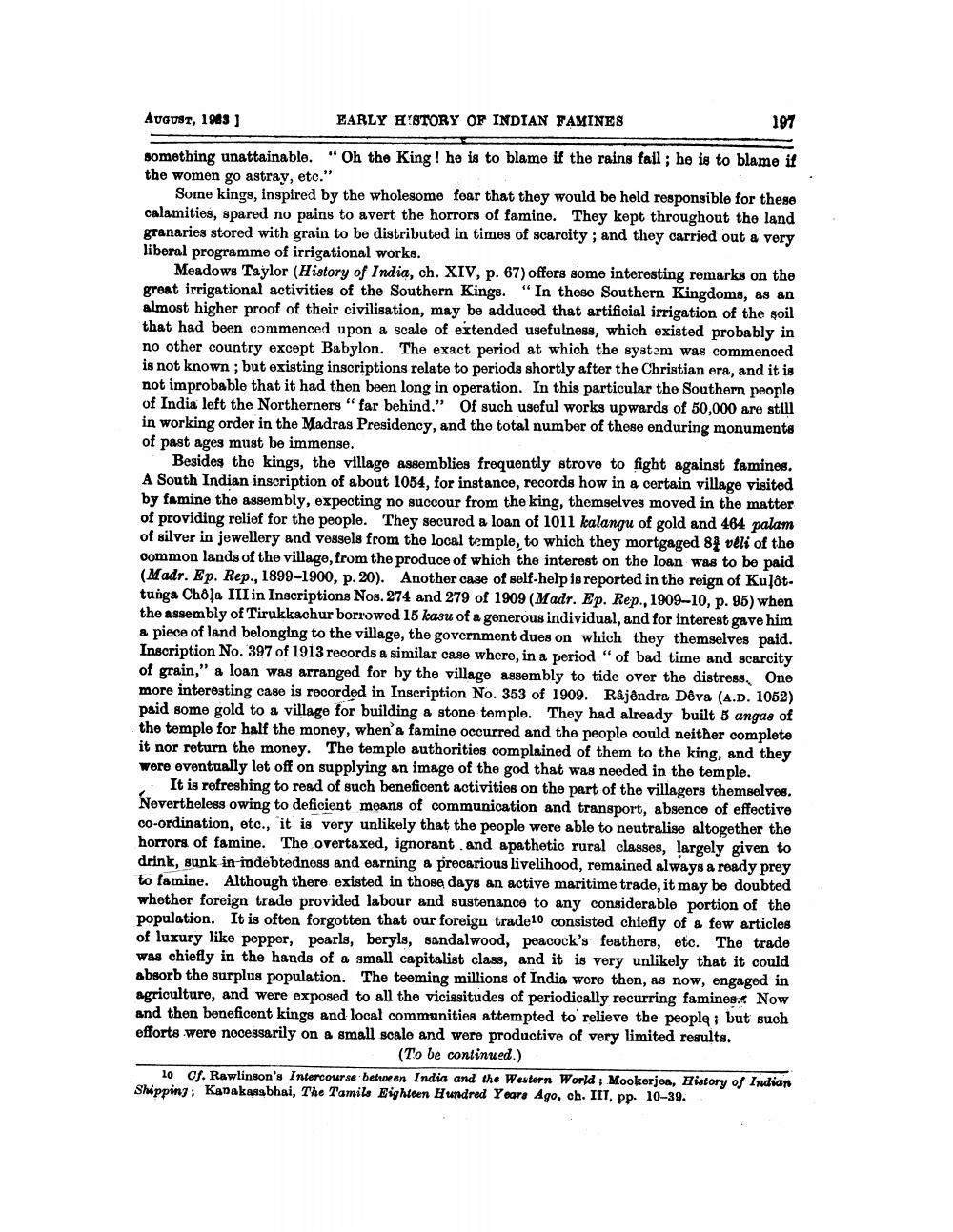________________
August, 1983)
EARLY H'STORY OF INDIAN TAMINES
197
WOEKO.
something unattainable. "Oh the King ! he is to blame if the rains fail; he is to blame it the women go astray, etc."
Some kings, inspired by the wholesome fear that they would be held responsible for these calamities, spared no pains to avert the horrors of famine. They kept throughout the land granaries stored with grain to be distributed in times of scarcity; and they carried out a very liberal programme of irrigational works.
Meadows Taylor History of India, ch. XIV, p. 67) offers some interesting remarks on the kroat irrigational activities of the Southern Kings. "In these Southern Kingdoms, as an almost higher proof of their civilisation, may be adduced that artificial irrigation of the soil that had been commenced upon a scale of extended usefulness, which existed probably in no other country except Babylon. The exact period at which the system was commenced is not known : but existing inscriptions relate to periods shortly after the Christian era, and it is not improbable that it had then been long in operation. In this particular the Southern people of India left the Northerners "far behind." Of such useful works upwards of 50,000 are still in working order in the Madras Presidency, and the total number of those enduring monumente of past ages must be immense.
Besides the kings, the village assemblies frequently strove to fight against famines. A South Indian inscription of about 1054, for instance, records how in a certain village visited by famine the assembly, expecting no succour from the king, themselves moved in the matter of providing relief for the people. They secured a loan of 1011 kalangu of gold and 464 palam of silver in jewellery and vessels from the local temple, to which they mortgaged 84 veli of the oommon lands of the village, from the produce of which the interest on the loan was to be paid (Madr. Ep. Rep., 1899–1900, p. 20). Another case of self-help is reported in the reign of Kuļôt. tunga Chola III in Inscriptions Nos. 274 and 279 of 1909 (Madr. Ep. Rep., 1909-10, p. 95) when the assembly of Tirukkachur borrowed 15 kasu of a generous individual, and for interest gave him a piece of land belonging to the village, the government dues on which they themselves paid. Inscription No. 397 of 1913 records a similar case where, in a period "of bad time and scarcity of grain," a loan was arranged for by the village assembly to tide over the distress. One more interesting case is rooorded in Inscription No. 353 of 1909. Rájöndra Deva (A.D. 1052) paid some gold to a village for building a stone temple. They had already built 8 angas of the temple for half the money, when'a famine occurred and the people could neither completo it nor return the money. The templo authorities complained of them to the king, and they were eventually let off on supplying an image of the god that was needed in the temple.
It is refreshing to read of such beneficent activities on the part of the villagers themselves. Nevertheless owing to deficient means of communication and transport, absence of effective co-ordination, etc., it is very unlikely that the people wore able to neutralise altogether the horrors of famine. The overtaxed, ignorant and apathetic rural classes, largely given to drink, sunk in indebtedness and earning a precarious livelihood, remained always a ready prey to famine. Although there existed in those days an active maritime trade, it may be doubted whether foreign trade provided labour and sustenance to any considerable portion of the population. It is often forgotten that our foreign tradelo consisted chiefly of a few articles of luxury like pepper, pearls, beryls, sandalwood, peacock's feathers, etc. The trade was chiefly in the hands of a small capitalist class, and it is very unlikely that it could absorb the surplus population. The teeming millions of India were then, as now, engaged in agriculture, and were exposed to all the vicissitudes of periodically recurring famines. Now and then beneficent kings and local communities attempted to relieve the people ; but such efforts were necessarily on a small scale and were productive of very limited results.
. (To be continued.) lo Of Rawlinson's Intercourse between India and the Western World: Mookerjes, History of Indian Shipping : Kapakasabhai, The Tamils Eighteen Hundred Years Ago, ch. III, pp. 10-39.




